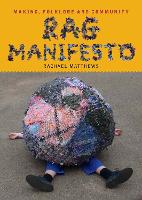


|
|
|
books
| book details |
Rag Manifesto: Making, folklore and community
By (author) Rachael Matthews, Foreword by Kathy Battista

|
| on special |
normal price: R 772.95
Price: R 733.95
|
| book description |
It's time to reconsider the value of our waste. In the past these were valuable commodities you could sell on. Gathering rag and turning it into yarn was rich in the possibility of making things. This Manifesto is a unique, artist's view of the traditional art of rag rug making for this age of the Anthropocene. Projects made in the artist's studio and with a community group, highlight a reverence for our lost textiles, a response to the environmental impact of fast fashion and a proof that rag is a rich resource, wrongly classed as a taboo material. In this book Rachael Matthews gives us permission to cut up our old fabrics offering a support structure for decision making and a chart on how to make liberating decisions about destroying a garment - be it 'Worn Out Emotional', or 'Brand New and Guilty' - and how our actions can develop community as well as our own self-esteem. A modernist interpretation of rag weaving European modernist painters, such as Ben and Winifred Nicholson, became interested in Rag Rug making in the 1920s. Picasso inspired freedom in creativity, using found materials and recognising that 'primitive' art was highly skilled. The art world missed a trick in not accepting these painterly rag works as true art and many have been lost. A century later, post pandemic, the need for a community to gather and make textiles was strengthened by a shared concern about the textile waste found on the streets where they live. This led to the artist founding Rag School, an on-line studio to rediscover the lost ways of making things. This led to a real-life rag studio with East London Textiles Arts, piloting ways that diverse communities everywhere could re-learn how to process textile waste in beautiful ways, caring for each other along the way. The transformation of waste has been a valuable remedy in recovering from the collective trauma of the pandemic: ripping is thrilling, storytelling cathartic, and the craft work a great place of focus and thought. The economic value of rag Textile manufacture is the second largest contributor to climate change and damage to the environment. The psychological impact that fast fashion imposed on us, has blurred our ability to see the potential of the materials we throw away. Popularity of handicrafts such as patchwork and dressmaking has led to an increase in knowledge of loveable, sustainable materials, but we often turn a blind eye to the more problematic fabrics. Some synthetic materials are unlikely to ever break down, while Itchy uniforms, saggy Lycra, odd socks, uncomfortable underwear and vulgar fashion statements come to their 'end of life' too soon. This book helps to break down all fears of what to do next with the rag pile. The stuff you loved can stay with you forever and the stuff you hated can be loved and laughed over in ways you never thought possible. Includes the techniques of plaiting; Welsh weaving sticks; peg loom; rigid heddle weaving; proddy on hessian; loomless weaving and passementerie. 'This special book deals with the urgent need to find ways of relating with textiles that, instead of contributing to social injustice and environmental degradation, actively contribute to the world. Stories change the future. The stories in this book are already changing things. They are about caring and repairing our places and communities with imagination, action and each other.' Professor Kate Fletcher, Royal Danish Academy - Architecture, Design, Conservation. Rachael Matthews is a ‘big thinker’ but more importantly she is a big doer. Her energy, enthusiasm and inventiveness are infectious. Her philosophy for dealing with the mass of textile waste that literally surrounds us is tangible. To follow in her footsteps all you need to do is to buy this book. Everything else is free. Freddie Robins, artist and Professor of Textiles, Royal College of Art, London
| product details |

Normally shipped |
Publisher | Quickthorn
Published date | 1 Mar 2024
Language |
Format | Paperback / softback
Pages | 0
Dimensions | 240 x 170 x 0mm (L x W x H)
Weight | 0g
ISBN | 978-1-7393-1603-7
Readership Age |
BISAC |
| other options |
|
|
|
To view the items in your trolley please sign in.
| sign in |
|
|
|
| specials |
|

|
Carlo Rovelli
Paperback / softback
224 pages
was: R 295.95
now: R 265.95
|
Originally published in Italian: L'ordine del tempo (Milan: Adelphi Edizioni, 2017).
|
|

|
Carlo Rovelli
Paperback / softback
208 pages
was: R 295.95
now: R 265.95
|
|
|
|
|